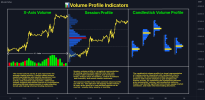skrimon
Active Member

The inclusion of trading volume as a standard indicator in charting software for the past three decades is not without reason—it offers a vital advantage.
Volume analysis grants traders valuable insights into the actions of market participants at different price levels. By focusing on volume, traders can react more effectively to price movements rather than attempting to predict the future direction of prices, as is often the case with many other technical indicators.
Key points about volume
Here are the key points regarding the volume indicator commonly plotted on the X-axis in trading:
Volume Indicator: The volume indicator calculates the total number of shares or contracts traded during a specified time period. It is usually displayed as a histogram or line chart, with time represented on the X-axis.
Liquidity: Volume is a critical metric as it provides insights into the liquidity of a security. Higher volume generally indicates greater market participation and liquidity, making it easier to buy or sell the asset without significantly impacting its price.
Confirmation: Volume can validate the authenticity of price movements. In an uptrend, increasing volume supports the bullish move, indicating strength and conviction among buyers. Conversely, declining volume during an uptrend may signal weakness or lack of interest. The same principles apply to downtrends.
Breakouts and Reversals: Volume analysis is often employed to identify breakouts and potential trend reversals. A significant increase in volume during a breakout suggests a higher probability of a sustained move, while decreasing volume near a support or resistance level might indicate a potential reversal.
Divergence: Volume can unveil discrepancies between price and market sentiment. For instance, if prices are rising while volume is decreasing, it could suggest that the rally is losing momentum and a reversal may be imminent. Similarly, increasing volume during a price decline might indicate selling pressure and the potential for further downside.
Confirmation of Patterns: Volume can serve to confirm or invalidate chart patterns such as triangles, head and shoulders, or double tops/bottoms. Higher volume during pattern formations enhances their reliability, while low volume can cast doubt on the significance of the pattern.
Watch for High Volume: Unusual spikes in volume can indicate significant market events, such as earnings releases, news announcements, or institutional buying/selling. Abnormal volume levels can lead to increased volatility and potentially present trading opportunities.
Relative Volume: Comparing current volume to historical average volume helps assess the significance of current trading activity. Higher volume relative to the average may imply increased interest, while lower volume might suggest a lack of conviction or reduced market participation.


